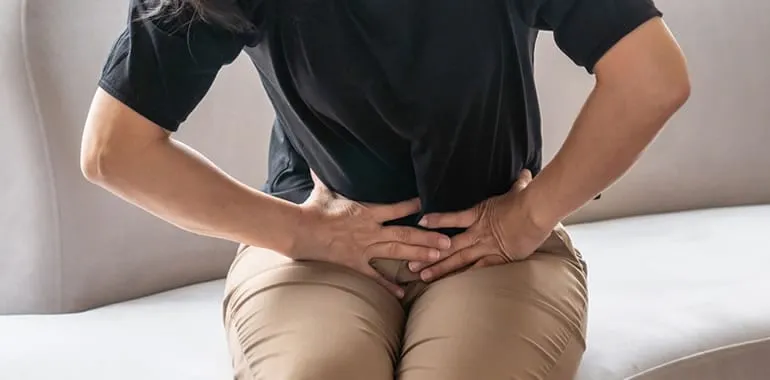Are People with Chronic Pelvic Pain just Crazy, like the medical community wants you to believe? The short answer is absolutely not. And here’s the long answer:
Trying to understand why pain becomes chronic in the absence of any objective physical findings, has been on my bucket list of things to crack and understand. Pain science and neuroplasticity have truly fascinated me since I started working in private practice. https://universuspt.com/is-my-pain-chronic-and-can-i-ever-get-relief/ I started my practice with very humble beginnings. I treated one patient at a time in a 350 square foot room for about 7 years. It was just me and the patient, no administrative staff, no one doing the scheduling; just me and the patient of course. In the beginning I didn’t have very many patients, so my schedule was WIDE open. If I saw two or three people in a day, it was a lot. This gave me a very unique opportunity. It allowed me to spend as much time as I wanted with someone. I could think about them in a way that was vast and deep. I was able to hear what their fears were, their hopes, and they allowed me to really be their guide on their healing journey, in a way that was not previously possible in a “mill-type” physical therapy clinic. To add to this, not too many doctors knew about me but the ones who did knew that I could help the patients they had who were considered “chronic”. Back then no one knew how to handle chronic pain patients. Most Physical Therapists at big corporations that I spoke with considered the chronic pain patient as the “difficult” or “crazy patient”. I knew there had to be more to it, how could this many people with the same problem all just be “difficult”? After decades of research we now know that this is just not the truth. They just didn’t have enough time for them. They never figured how to help them.
Everything had to get updated, their mindset, their nutrition, their sleep regime.
What I learned in my deep personal research of people who have chronic pain is that, if there is no objective tissue damage and the person was still in pain, we needed to do something drastic. We needed to make big changes in order for the whole system to start to change. Everything had to get updated, their mindset, their nutrition, their sleep regime. The tissue themselves were not injured, yet they had a memory and can ‘remember’ and recreate the pain even when the original source had gone away. The neurological system had created a new pathway for pain. The brain now has a default mode for pain. Anything having to do with the tissue in question would produce pain.
People with chronic pelvic pain have a tendency to focus tension in the pelvic floor under stress.
A condition that I helped many women work through was chronic pelvic pain. I saw evidence of tissue memory in the work I did with pelvic pain and dysfunction. No one with pelvic pain says that their symptoms are comfortable or normal. However, it may be that your body has adapted to your pain and dysfunction as a normal state. People with chronic pelvic pain have a tendency to focus tension in the pelvic floor under stress. Over time this ongoing tension shortens the pelvic muscles and makes for an uncomfortable environment for the muscles, nerves and tissue involved in the pelvic floor. The shortened state of the muscles of the pelvic floor do not allow for normal relaxation, flexibility, and function of that tissue. Under these conditions, the tissue will consistently not do its job when its asked to due to the faulty messaging that it gets from the brain. It could very well be that you’re losing urine and when I ask if you have pelvic pain, you say you don’t. If I were to assess the tissue tension of the pelvic floor and its ability to relax, there would be dysfunction, 9 times out of 10. In this scenario, we are needing to do some trigger point release of these pelvic muscles to unknot the pelvis and deactivate the trigger points. If we can’t release them, they can’t work to their full capacity. Another thing that the pelvic floor is allowing you to do is have a bowel movement. If you have constipation and you’ve tried every laxative or fiber supplement yet are still having issues, your pelvic floor just may not be doing its job at allowing you to have a bowel movement. The pelvic floor muscles also need to relax during intercourse, or it will feel extremely painful! Why can’t the pelvic floor relax during a seemingly relaxing activity? This one is a big one to dig into, maybe I’ll save it for another blog. But the short answer is, the pelvic floor is tensed and getting faulty messages from your brain. This is at the crux of chronic pelvic pain.
Healing from Chronic Pelvic Pain
So how do we begin to heal from chronic pelvic pain? The first step is to REALLY understand the cause of your pain. If it is that your brain has gotten involved and created faulty and frequent pain signals, well than that needs to get disassembled. If it is that there is an underlying lower back problem that you never fully healed from which is causing your pelvic muscles to go into spasm and pain for no good reason, then your back needs to get fixed. This is the thought process that needs to be at the focal point of step one. We need to identify the REAL, TRUE root cause of your pain.
Let’s go through a few different scenarios and how you would identify which problem you have and start to get some help on how to recover.
Let me just say that to identify if your brain has in fact developed faulty messaging to your pelvic floor tissue, in order to make that determination, we first need to rule out ALL other objective reasons for the pain. Meaning, we NEED to do an exam and maybe even a session or two of treatment to decide the course of action. We need to get to know you. We need to identify what stressors you have in your life and if in fact the pain is centrally mediated. If that is in fact the case, we need to create a plan that involves REALLY learning how to relax those muscles. Much research has been done on progressive relaxation technique. https://www.mayoclinic.org/healthy-lifestyle/stress-management/in-depth/relaxation-technique/art-20045368
We also need to treat the whole body. “The body keeps score” (it’s a book by Bessel Van Der Kolk). If I had thought to write that book, I would have called it, “The whole body keeps score”. It is a fascinating book. My takeaways were that trauma and stress very much live in the muscles and fascia of the body. We are seeing people with chronic lower back pain who had a 10-year-old foot fracture that they developed scar tissue over which in turn created tension all the way up the chain, even into the neck and causing headaches.
You need to treat the whole system.
In order to fully recover from pelvic pain that is centrally mediated (meaning the brain is giving the tissue faulty information), you NEED to treat the whole system. Everything has been affected. To this effect, you need to learn how to breathe and breathe often and breathe through stress and not let stress tense your muscles. You need to exercise regularly and eat a non-inflammatory diet. The reason for those tips are that if your body is truly in this state, it is very sensitive. It is sensitive to things like inflammation, toxins, emotional stress, etc. It is more sensitive than most people’s bodies. So, you need to give yourself the best possible chance at feeling good and you need to do it often. Often enough that the brain begins to change, this process is known as neuroplasticity. Neuroplasticity is “the ability of the nervous system to change its activity in response to intrinsic or extrinsic stimuli by reorganizing its structure, functions, or connections.” https://pubmed.ncbi.nlm.nih.gov/32491743/ Repetition is the key to change. Some repetitive movements that are safe and needed for the body to start to recover. The thing is you need to do these exercises 3-x per day. They are tiny exercises. You can usually do them at work and we work them into your schedule. “The brain that changes itself” by Norman Doidge, is another fascinating book about the inner workings of neuroplasticity and how if given enough time and repetition the brain can create new pathways and get rid of old unwanted pathways. It is though, a process. We need a few things: Patience, diligence, and a good plan.
What you can do at home for Chronic Pelvic Pain:
If your pelvic floor is of the non-relaxing type however there are no real significant brain updates that we need to do, there are some super helpful exercises that will work to relax the pelvic floor and give relief from pain:
I hope I’ve done an OK job of explaining how chronic pain works and how it relates to chronic pelvic pain. Please give these exercises a try and let me know how you feel in 30, 60 or 90 days. It does take time to see change, so don’t give up too soon! And if you feel like you want some help or advice, I am happy to answer any questions you have about your pain.


